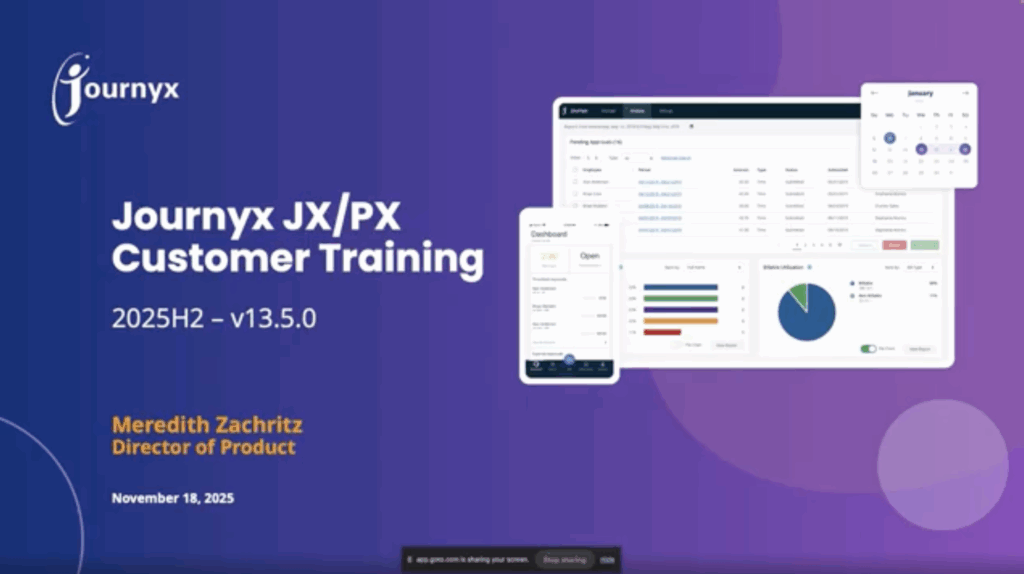Marketing KPIs That Matter
 Written by Lance Ellisor, Chief Operations Officer, Journyx, Inc.
Written by Lance Ellisor, Chief Operations Officer, Journyx, Inc.
Introduction
In the opening post of this series, I laid out a set of company-wide metrics that drive enterprise value, as the starting point for understanding how outcome-based performance management ties directly to the primary goals of a for-profit business. One might call those the “parent KPIs”. For most of the rest of the series, I’ll be focusing on the “child KPIs”: the metrics that matter for each of the most common functional areas of a business.
In this post, I’ll zoom in on the front end of the revenue engine—the marketing function—where tracking the right KPIs can optimize revenue growth, enhance customer engagement, and directly contribute to other company-wide KPIs.
An effective marketing organization doesn’t just generate leads—it drives sustainable and profitable growth, aligning closely with some key factors in enterprise value, such as Revenue Growth, Net Profit Margin, and LTV:CAC Ratio, all of which we covered in the introductory post. Below, I’ll lay out the Marketing KPIs that I value most as an operator, how they contribute to these broader goals, how to track them, and how they interact with each other.
Key Marketing KPIs
Engagement KPIs
Engagement is the level of interaction and involvement that your target audience has with your organization’s content, website, or social media platforms; high engagement suggests more audience awareness and interest in your brand and your content, which in turn lay the foundation for demand generation. These KPIs will probably already all be in any marketer’s toolkit, but I feel I should still include them, as they are so important.
Website Traffic
What It Measures: The number of visits or visitors to a company’s website
Why It’s Important: Website traffic is an essential indicator of brand awareness and the effectiveness of digital marketing efforts. More visitors to the website mean more opportunities to convert leads, which ultimately drives Revenue Growth.
How to Measure: Use web analytics platforms like Google Analytics or HubSpot to monitor visitor numbers, bounce rates, time spent on site, and user behavior such as navigation paths. Segment data by traffic sources (organic, paid, direct) for deeper insights.
Reference: For more insights on website traffic, check out SEO agency Victorious’s guide on web traffic measurement
Content Engagement Score
What It Measures: A composite metric that tracks how audiences engage with content such as blogs, videos, landing pages, case studies, or webinars.
Why It’s Important: High content engagement reflects the relevance (to the audience) and the quality of marketing content. Relevant, high-quality content both attracts more (and more interested) potential buyers and gives them a reason to return to the content if they don’t identify themselves initially, as well as a reason to share it with others within or outside their organization.
How to Measure: Use analytics tools to measure metrics like page views, time on page, shares, and comments, and combine them into a composite engagement score.
Reference: HubSpot has a comprehensive summary of these metrics
Social Media Engagement
What It Measures: This KPI tracks interactions on social media platforms, such as likes, shares, and comments.
Why It’s Important: Social media engagement is a key measure of brand presence and customer interest. High engagement levels indicate effective social media strategies and can indirectly support a higher Net Promoter Score (NPS) by strengthening customer relationships.
How to Measure: Use social media analytics tools to monitor engagement metrics across platforms such as LinkedIn, Facebook, X, and YouTube.
Reference: For more insights into social media metrics, see Sprout Social’s guide
Lead Generation and Conversion KPIs
The core mission of Marketing is to maximize the connection to the market, generating as much meaningful demand for an organization’s offerings as possible. Following are the KPIs for this dimension that my organization values the most.
Leads Generated
What It Measures: The total number of potential customers identified through marketing efforts.
Why It’s Important: Leads generated is a core KPI that reflects the effectiveness of marketing campaigns. More leads filling the sales pipeline directly support Revenue Growth by increasing the pool of potential customers.
How to Measure: Track lead sources and volume using marketing automation tools and CRM systems. Segment leads by source to identify high-performing campaigns.
Marketing Qualified Leads (MQLs)
What It Measures: MQLs are leads that have been vetted by marketing and deemed likely to become customers based on their engagement and fit.
Why It’s Important: MQLs help ensure that the sales team focuses on prospects with a higher likelihood of converting, thereby improving Customer Acquisition Cost (CAC), Net Profit Margin, and driving Revenue Growth.
How to Measure: Track MQLs using CRM systems and marketing automation tools, using predefined criteria such as content engagement and firmographic data.
Reference: For more on MQLs and how to identify them, refer to Tableau’s blog
Average Time to Conversion
What It Measures: The time taken from lead acquisition to conversion.
Why It’s Important: Reducing the time to conversion enhances conversion rates by moving leads through the funnel more quickly, which improves Cash Flow and accelerates Revenue Realization.
How to Measure: Use CRM systems to track the lead lifecycle, identifying bottlenecks that slow down conversion.
Average Time to Conversion = Average of (Time of Lead Conversion – Time of Lead Acquisition) for all leads in a given observation period
Conversion Rate
What It Measures: The percentage of leads or website visitors who take a desired action, such as signing up for a newsletter or making a purchase.
Why It’s Important: High conversion rates demonstrate the effectiveness of marketing efforts in driving customer actions. Improving conversion rates positively impacts the Net Retention Rate by ensuring that leads progress through the funnel efficiently.
How to Measure: Use web analytics tools to measure the conversion of visitors into leads or customers across different traffic sources.
Conversion Rate = (Number of Conversions / Total Visitors) * 100
Pipeline Delivered
In organizations that I operate, this is the “most key” of the key performance indicators for marketing
What It Measures: Pipeline Delivered quantifies the total potential revenue generated by marketing activities that is handed over to the sales team. It reflects the dollar value of all sales opportunities that entered the pipeline as a direct result of marketing efforts.
Why It’s Important: This KPI is critical for measuring the direct financial impact of marketing on the sales pipeline. A higher dollar value in the pipeline indicates that marketing is effectively generating high-value leads, which can drive Revenue Growth. By delivering a robust pipeline, marketing can help sales focus on opportunities with the greatest revenue potential.
How to Measure: Pipeline Delivered can be tracked by summing the total value of all qualified leads (MQLs or SQLs) generated by marketing and passed on to sales. CRM systems allow teams to tag and monitor the source of each lead and track its monetary value throughout the pipeline.
Pipeline Delivered = Sum of the value of all marketing-sourced leads in the sales pipeline
Connection to Company-Wide KPIs: A strong pipeline delivered most directly contributes to Revenue Growth, making sure that the sales team has enough high-value opportunities to convert into booked deals.
Marketing Effectiveness KPIs
These KPIs represent a measure of marketing efficiency: how well Marketing converts spend into growth for the company.
Return on Marketing Investment (ROMI)
What It Measures: The revenue generated from marketing activities relative to the cost.
Why It’s Important: ROMI provides a summary indicator of how effectively marketing resources are being utilized in supporting growth through sales. A higher ROMI signals marketing efficiency and contributes to improving Net Profit Margin as well as LTV:CAC Ratio.
How to Measure:
ROMI = (Booked Revenue from Marketing Efforts – Marketing Spend) / Marketing Spend
References:
Customer Acquisition Cost (CAC)
What It Measures: The total cost of acquiring a new customer, encompassing both marketing and sales expenses.
Why It’s Important: Lowering CAC directly improves Profit Margin and indirectly impacts Revenue Growth by ensuring that marketing budgets are used efficiently to drive customer acquisition. CAC is the denominator of the company-wide KPI LTV:CAC Ratio.
How to Measure: CAC is calculated as the total of all marketing and sales expenses divided by the number of new customers acquired. Although there are several variants, one simple formula is:
CAC = (Marketing Expenses + Sales Expenses) / Number of New Customers
Reference: Learn more about CAC and its calculation from HubSpot
Conclusion
Tracking and optimizing performance against the right Marketing KPIs is foundational for both the effectiveness of your marketing operations and for contributing to broader company success. Taken together, KPIs of :
- engagement,
- lead and conversion rates, and
- marketing efficiency
offer a considerably complete picture of the overall value contribution of your marketing function. They also serve as excellent performance metrics underpinning outcome-based performance management, an approach which is usually a good practice, but essential in a remote or distributed work environment.
Associated articles:
- Company-Wide KPIs
- Next up: Sales KPIs
Let’s Get Started. Book a Demo Today.
Journyx helps you track time for projects, payroll, and more. Learn how Journyx can help you use time to your advantage in your business.



